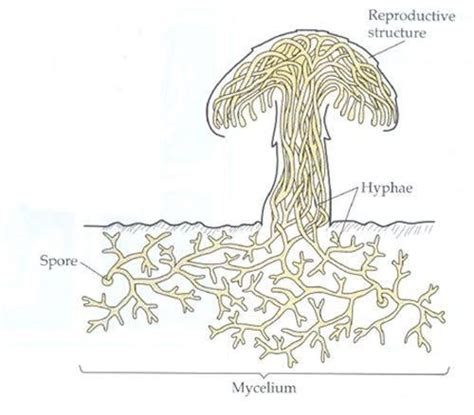At 3.7 Square Miles a Fungus in Eastern Oregon is the Largest Living Organism on Earth
Posted on November 3, 2022

According to microscopic fossil evidence,* filaments from fungi mycellium have been present on Earth for roughly half its four billion year existence. Micro-fossils with mycellial structures in 2.4 billion year-old South African lava are either fungi or fungi precursors.
Other fossil evidence suggests fungi moved from the sea to land around the same time algae did (538 million to one billion years ago) feeding on decaying algae and bacteria.
Genetic studies indicate that the immense underground mycellium networks found in forests belong to a genetically unique single organism. Some fungal networks are as large as 3.7 square miles, making them the largest organisms on earth. One giant fungus in Eastern Oregon has been carbon dated as 2,400 years old.
The hyphae (filaments) that grow outward from the mycellium contain potent enzymes enabling fungi to break down wood, rocks, asphalt and even keflar. Mycellia also exhibit a rapid communication network (similar to the electrical signaling in our nervous system) along the filaments, memory and limited problem solving ability. When tested in specially designed mazes, fungal hyphae nearly always find the fastest route to the end.
Mycellial networks form an intricate relationship with the root systems of trees and other plants that facilitates absorption of nutrients, as well a warning system alerting them to potential threats from insects and other plant predators. Fungal networks also play some role in moving carbon from carbon-dense areas to more depleted areas.
Fungi have long been important to human health, with Neanderthal, ancient Egyptian and Australian aboriginal skeletons showing evidence of grinding penicillin mold into their teeth (for dental problems).
Human beings have long used other fungi for their psychodelic properties. Historical examples include the Aztecs, who used psylocibin mushrooms to commune with their serpent god Queztel. The Greek philosopher Plato is believed to have been a participant in the secret, cult-like Eleusinian Mysteries based on the hallucinogenic ergot fungus (from which LSD was first synthesized).
Some anthropologists attribute the great cognitive leap Homo sapiens made 11,500 years ago (resulting in the agricultural revolution) to their discovery of mind expanding fungal hallucinogens.
The film also reports on fungi thriving in Chernobyl’s contaminated zone that seem to derive energy from ionizing radiation, and a process known as “lichenization.” LIchens form when fungal cells pair up with specific algae in a mutually beneficial relationship.
*When treated with special stains, fungal filaments test positive for chitin, a tough polysaccharide polymer that is also found in the exoskeletons of insects and arthropods.
**Myceliium is the root-like structure of a fungus consisting of a mass of branching, thread-like hyphae.
https://youtu.be/KH9JVy-u5DQ
Thanks to: https://stuartbramhall.wordpress.com/2022/11/03/at-3-7-square-miles-a-fungus-in-eastern-oregon-is-the-largest-living-organism-on-earth/
Posted on November 3, 2022
The Key to Life: Evolution of Fungi
Directed by Pete Kelly (2022)
Film Review
According to microscopic fossil evidence,* filaments from fungi mycellium have been present on Earth for roughly half its four billion year existence. Micro-fossils with mycellial structures in 2.4 billion year-old South African lava are either fungi or fungi precursors.
Other fossil evidence suggests fungi moved from the sea to land around the same time algae did (538 million to one billion years ago) feeding on decaying algae and bacteria.
Genetic studies indicate that the immense underground mycellium networks found in forests belong to a genetically unique single organism. Some fungal networks are as large as 3.7 square miles, making them the largest organisms on earth. One giant fungus in Eastern Oregon has been carbon dated as 2,400 years old.
The hyphae (filaments) that grow outward from the mycellium contain potent enzymes enabling fungi to break down wood, rocks, asphalt and even keflar. Mycellia also exhibit a rapid communication network (similar to the electrical signaling in our nervous system) along the filaments, memory and limited problem solving ability. When tested in specially designed mazes, fungal hyphae nearly always find the fastest route to the end.
Mycellial networks form an intricate relationship with the root systems of trees and other plants that facilitates absorption of nutrients, as well a warning system alerting them to potential threats from insects and other plant predators. Fungal networks also play some role in moving carbon from carbon-dense areas to more depleted areas.
Fungi have long been important to human health, with Neanderthal, ancient Egyptian and Australian aboriginal skeletons showing evidence of grinding penicillin mold into their teeth (for dental problems).
Human beings have long used other fungi for their psychodelic properties. Historical examples include the Aztecs, who used psylocibin mushrooms to commune with their serpent god Queztel. The Greek philosopher Plato is believed to have been a participant in the secret, cult-like Eleusinian Mysteries based on the hallucinogenic ergot fungus (from which LSD was first synthesized).
Some anthropologists attribute the great cognitive leap Homo sapiens made 11,500 years ago (resulting in the agricultural revolution) to their discovery of mind expanding fungal hallucinogens.
The film also reports on fungi thriving in Chernobyl’s contaminated zone that seem to derive energy from ionizing radiation, and a process known as “lichenization.” LIchens form when fungal cells pair up with specific algae in a mutually beneficial relationship.
*When treated with special stains, fungal filaments test positive for chitin, a tough polysaccharide polymer that is also found in the exoskeletons of insects and arthropods.
**Myceliium is the root-like structure of a fungus consisting of a mass of branching, thread-like hyphae.
https://youtu.be/KH9JVy-u5DQ
Thanks to: https://stuartbramhall.wordpress.com/2022/11/03/at-3-7-square-miles-a-fungus-in-eastern-oregon-is-the-largest-living-organism-on-earth/






 Sat Mar 23, 2024 11:33 pm by globalturbo
Sat Mar 23, 2024 11:33 pm by globalturbo

